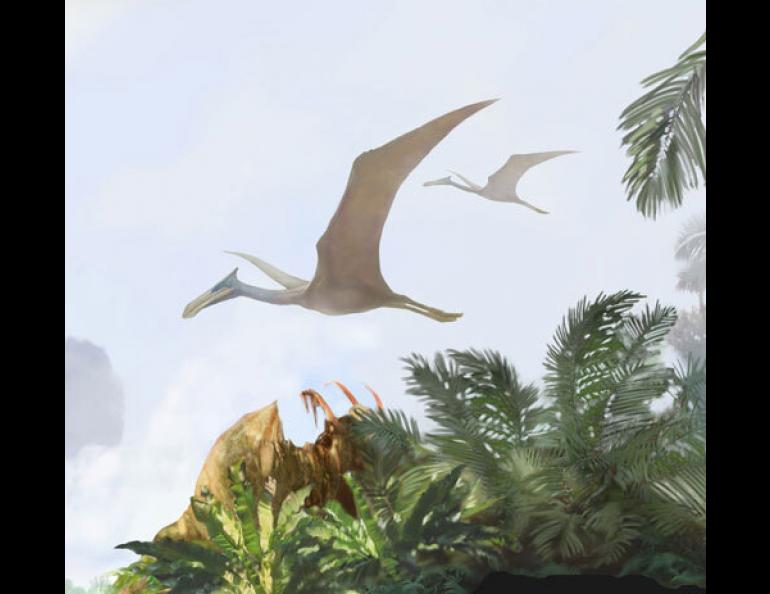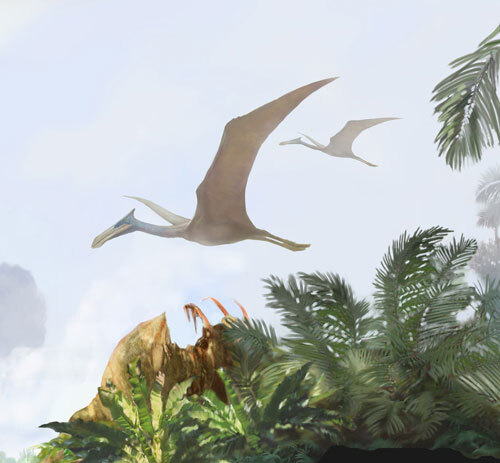
Scientists discover track of soaring prehistoric creature
While hiking a hillside in Denali National Park last July, Steve Hasiotis bent down and picked up a rock. Its curious shape, like a plaster cast of a giant bird track, made him ponder the rock for a second before handing it to Tony Fiorillo. Fiorillo looked at it and confirmed they had found a missing piece of Alaska during the time of the dinosaurs.
“I said, ‘This looks like a pterosaur handprint,’” said Fiorillo, of the Museum of Nature and Science in Dallas, Texas. “Because we knew they’d never been found before (in Alaska), we were pretty excited.”
A pterosaur was a winged creature closely related to both crocodiles and dinosaurs. Seventy million years ago, it soared over Alaska like a giant albatross, casting a wide shadow beneath its 25-foot wingspan. The recent discovery by Hasiotis, Fiorillo, Yoshitsugu Kobayashi, and Susie Tomsich is the first record of a pterosaur from Alaska. The state has become a rich ground for paleontologists in the last few decades, with massive bone deposits off the Colville River and recent discoveries in Denali National Park.
“The North Slope is cool, but the thing that’s missing from the North Slope is that there’s this great niche we know nothing about,” Fiorillo said from Dallas recently. “In Denali, for the first time, we have an idea of what was in the air (70 million years ago).”
Fiorillo, Hasiotis (from the University of Kansas), Kobayashi (from Hokkaido University Museum), and Tomsich (from the University of Alaska Fairbanks) co-authored a paper on the Denali pterosaur that appeared in a recent issue of the journal Palaios.
The creature that left the impression of its hand off the Denali Park road was perhaps about 35 pounds, and glided over waterways with the occasional flap of its hang-glider wings. The pterosaur might have been a fish-eater, due to the large number of fish fossils found in Denali National Park, Fiorillo said.
“It might have cruised over the top of the water like a bald eagle, or maybe a pelican,” he said. “There’s no modern analogue for these animals.”
The landscape of Interior Alaska 70 million years ago was a flat floodplain with many small river channels, some lakes, fern fronds, Equisetum stems, and sequoia-type trees. Except for some of the evergreen species, the vegetation wasn’t a whole lot different than today. Fiorillo said that if you were to look out your window, say in Fairbanks, the ancient landscape would look a lot like it does right now.
The pterosaur of Denali Park had a wing that was like a long extension of its pinky finger, with a membrane flowing behind. Pterosaurs used a bend in their folded wing as a hand that helped them walk. Millions of years ago, a pterosaur ambled over a muddy riverbed in the Denali area, leaving a track that hardened and filled with sediment that became rock. That rock outlasted the track impression that created it, and became the natural cast that Hasiotis picked up last July.
Fiorillo does some of his fieldwork in Texas, but spends a good chunk of his summers in Alaska. This year, he’ll be working in Yukon-Charley Rivers National Preserve and Denali Park again. He seems to find something exciting there every year, and he hinted of a few other discoveries that haven’t yet been published.
“Denali’s skies seem to have been very busy,” he said.





